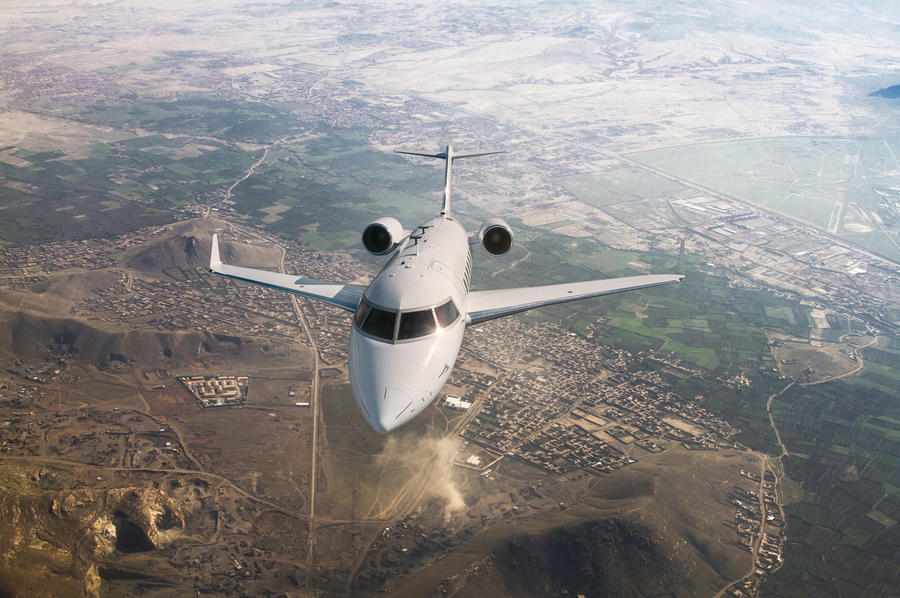The race to make a specialized plane that sees farther while staying safer
A Leidos team turned a civilian jet into a groundbreaking electronic signals platform in barely a year — and at no cost to the government.
The modern battlefield has grown increasingly complex and high tech, making the ability to electronically see targets and threats from further away a significant advantage.
To that end, the U.S. Army has set its sights on deploying aircraft that can meet several paramount criteria. These needs include extending electronic sensing deep into the threat environment in order to deliver long-range precision fires, while remaining outside the range of air defense artillery. The speed and unpredictability of conflict today also requires an aircraft that can quickly get to a hot spot from a distant base. At the same time, the aircraft must be able to loiter on station for hours on end.
In the beginning of 2019, a Leidos team set out to produce an aircraft that would meet all of those requirements. Doing so while keeping costs down would be an ambitious undertaking. Yet, a year later, a ready-to-deploy plane called the Leidos Special Mission Aircraft (LSMA) would be making commanding first impressions. The aircraft demonstrated that it could serve as a next-generation high-altitude electronics intelligence platform in the most demanding threat environments.
Deep sensing
Building a state-of-the-art flying signals intelligence platform starts with choosing the base aircraft. It didn't take the team long to find the right plane for the LSMA project: the Bombardier Challenger 650.
LSMA Performance Specs
Click the icons to learn more
“Other aircraft that have the LSMA's capabilities would leave the Army with multi-billion-dollar bills to rebuild infrastructure to accommodate their wingspan," says Michael Chagnon, Deputy Defense Group President for Leidos. He adds that unlike most jet aircraft in this class, the LSMA is able to operate efficiently at altitudes that support many different types of missions.
Invested in the outcome
To add to the challenge, the Army wanted advanced ISR capabilities, quickly, and in a platform that provides both unusual versatility and a low cost of ownership. Meeting all those goals meant the Leidos team would have to innovate not just with design and engineering, but with the LSMA's business model. “We wanted to do this for a fraction of the cost of what a typical government aircraft program would run," says Chagnon. “So we embraced our entrepreneurial spirit."
Leidos took on the risk of developing the military aircraft with zero dollars from the Army or DoD, which is unusual for such programs. “We made sure we had skin in the game," says Chagnon. “That gave us a vested interest in making sure it was the right aircraft for the warfighter." In addition, LSMA is being offered under a company-owned and company-operated (COCO) model, and the aircraft is fully maintained by Leidos. It’s intended to be leased to the Army on a monthly basis, keeping total cost of ownership low and tightly controlled.
To provide even more value and capability, the team took full advantage of the generous interior space to make LSMA not only a next-level ISR platform, but a multi-mission vehicle. As a deep-sensing electronics-intelligence aircraft, LSMA can support up to six separate rack-mounted equipment stations, all fed by the array of antennas that leave the exterior skin of the aircraft bristling with small, sleek fins and nubs.
Any or all of the stations can be removed intact, wiring and all, and wheeled right off the plane, to be replaced by up to 16 seats — to accommodate extra operators, crew or troops — in just hours. In addition, the electronic intelligence equipment is entirely open architecture and swappable at the box, board, or card level. “We have the very latest technology on the aircraft," says Chagnon. “But everything moves so fast that a year from now there might be something better to integrate, and you'll be able to do it in hours instead of having to take the plane down for several months for reconfiguring." The ability for a single aircraft to serve in multiple mission capacities translates to lower costs in training, logistics, and maintenance, notes Chagnon.
The unique combination of easily swappable components, impressive speed, and high endurance provides a valuable advantage when it comes to servicing or upgrading LSMA during deployment in hard-to-reach locations such as Afghanistan. Other aircraft would have to wait five or more days for needed parts to arrive from the U.S., and then spend days or even weeks on the ground while the work was done. But LSMA can simply fly straight to a Leidos maintenance facility, have parts or modules swapped out in hours, and then return to the mission. "We can have the plane back in the fight 72 hours after it leaves Afghanistan," says Chagnon. "That's half the time it takes just to ship a part there."
If the Army or another Service wants to make design changes to LSMA, that can happen quickly, too, by virtue of Leidos having licensed the rights from Bombardier. “With most corporate aircraft, you have to put in a request to have the manufacturer make the changes, and you can end up in line behind a celebrity who wants gold faucets put in the lavatory," says Chagnon. “With these rights, we can make the changes and obtain the certification on our own, right away."
Into action
In late July, just 14 months after the team began work on LSMA, the aircraft flew to Japan where it was put through its paces in the Pacific theater as a technology demonstrator for the Army, which is evaluating its capabilities. After that, it's slated to head for Europe for more demonstrations and exercises. If and when the Army or other military branches are ready to start building a fleet of LSMAs, Leidos is prepared to start turning them out at a rate of one per month.
That's a long way to come in a little over a year, says Chagnon. “Last year, when we briefed our plan, many thought it could not be done, they just laughed," he recalls. “Now they're amazed at what we've done."





